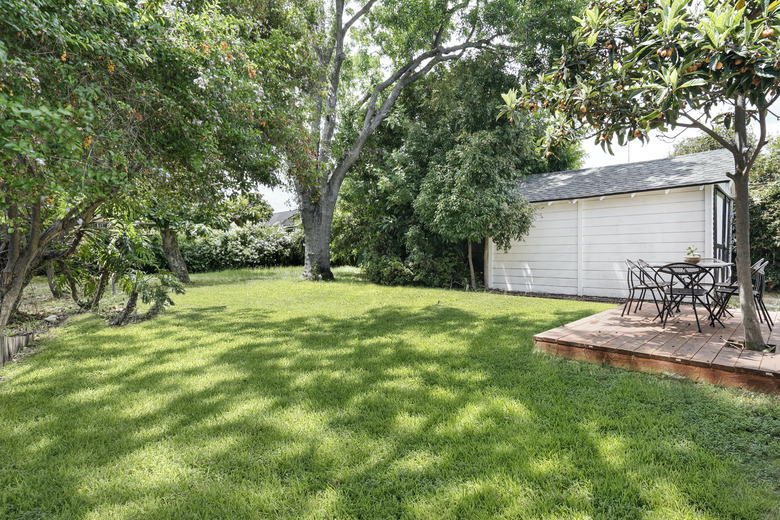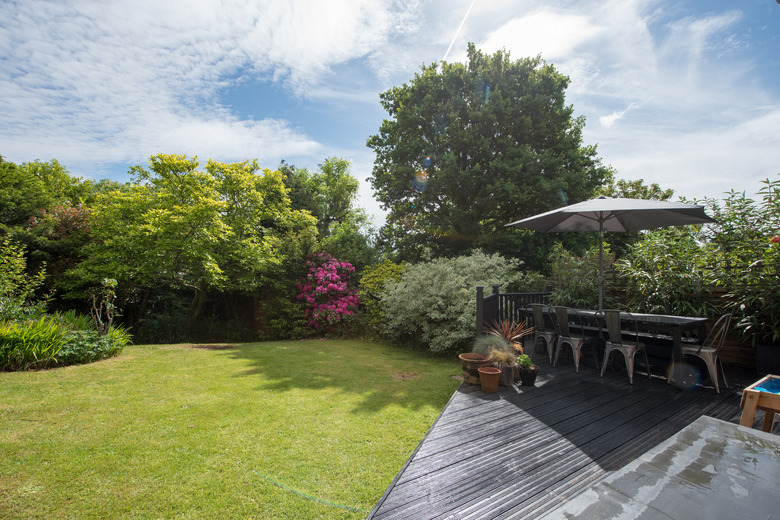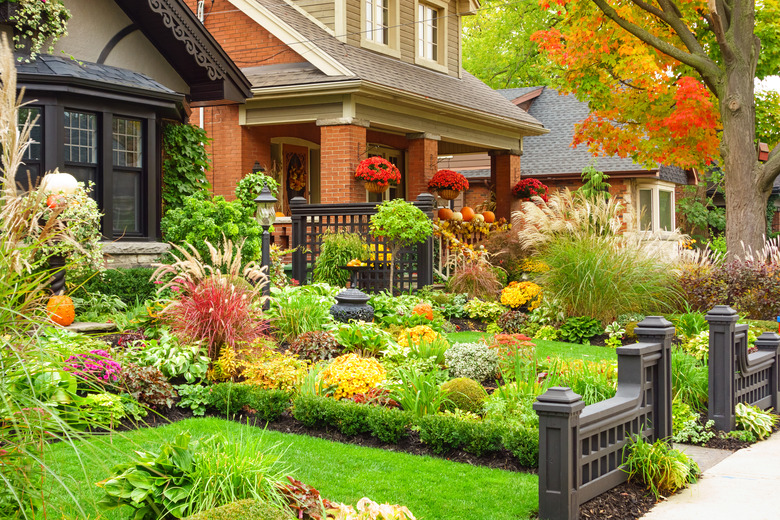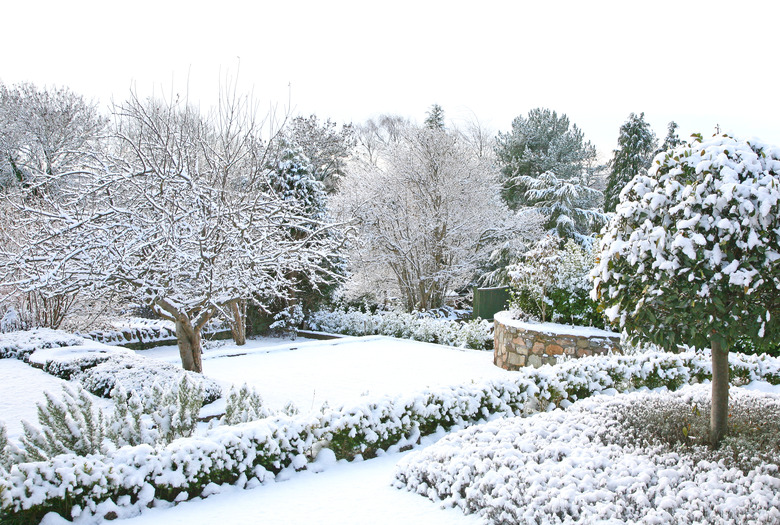A Homeowner's Guide To Seasonal Landscape Maintenance
We may receive a commission on purchases made from links.
Just as your landscape changes from one season to another, your seasonal landscape maintenance tasks will change with each of the four seasons. Though many homeowners eagerly await the end of summer for a bit of a break—the incoming autumn does not mean the end of taking care of your landscape, but it will require that you perform different maintenance tasks during seasons of growth and rest. Creating and adhering to a seasonal landscape maintenance schedule or checklist will help keep your yard looking fantastic no matter the season.
Spring Yard Maintenance
Spring Yard Maintenance
The arrival of spring brings longer daylight hours and warmer temperatures, meaning it's time to get all those landscaping tools and supplies out of storage and prepare for the upcoming summer. Start by inspecting your yard for fallen and damaged branches and plants. Clean up and rake leaves and debris in your yard, particularly in plant beds. Prune dead or damaged tree branches, and prune and plant roses, vegetables and flowers.
Spring is when you'll want to fertilize around your trees, shrubs and gardens and add a layer of mulch in flower beds and around trees and shrubs. Once the ground has thawed and the snow is gone, you can add fertilizer to your lawn. You can also dethatch your lawn to help improve grass growth and water absorption. Late spring is the perfect time to seed and fertilize your warm-season turfgrass lawn, applying a weed killer if needed. Don't forget to inspect your lawn mower and other lawn tools and perform any needed repairs or tune ups because you'll need them once the plants and grass start to grow.
Once the winter chill has gone, it's also the optimal time to clean your deck or porch and add a coat of stain or paint. Additionally, you'll want to inspect and set up your lawn and deck furniture. And to prepare for all of the flowerbed watering, turn on your sprinkler or irrigation system and check for leaks. Other maintenance tasks include inspecting and repairing your hardscapes—looking for things like damaged walkways, replacing gravel that may have washed away during the winter on patios or driveways and repairing any damage to outside fixtures, such as fences, lights and doors.
Summer Landscape Care
Summer Landscape Care
Summer brings heat and lots of sunshine, so plenty of water is essential to keep your plants healthy and vibrant. It is best to water plants in the morning to avoid the midday heat and to give your plant foliage time to dry during the day, which reduces the fungal diseases that spread because of wet plants. Pay particular attention to any new plants, shrubs or trees. Grass should receive approximately an inch of water per week. Don't forget to regularly water any potted plants you might have on your deck or porch.
Mow the lawn on a regular schedule and try to do it during the morning or evening to avoid the midday heat, which can damage the cut grass. Summer is when weeds and crabgrass will really start to grow everywhere, including your vegetable garden and between pathway pavers, so weed or apply weed treatment and add a layer of mulch if necessary. Some hedges and shrubs will also need to be pruned during the summer to promote healthy growth. Lastly, fertilize your flowers and vegetables on a regular schedule, based on the type of plant and existing soil fertility. Your lawn can also be fertilized during the summer if necessary.
Fall Landscape Maintenance
Fall Landscape Maintenance
Fall usually means a lot of raking and cleaning leaves from your lawn and your garden beds. The raked leaves don't need to be wasted because they can be used as compost (it's best to chop them up with a lawn mower or leaf vacuum/shredder first). It's also a good time to fertilize and seed lawns of cool-season turfgrasses around the middle of September. Overseed the entire lawn and pay particular attention to bare or problem areas.
The autumn months are a good time to pull weeds and prevent them from growing back the following year. Dividing and replanting perennials that have grown too big or that you want to transplant to another area, should also be at the top of your fall landscape maintenance list. As for your trees, mulch and water them, as well as any shrubs and anything newly planted before the ground freezes and before shutting off the outside water. Cut your lawn one last time before the season ends and leave it between 2 and 2 1/2 inches long to keep the roots strong.
Now that the weather is cooling down, it's time to clean and store lawn and garden tools. Add a fuel stabilizer like STA-BIL or run your lawn mower until it is out of gas to ensure it will start the following year. After removing and storing hoses, turn off and drain your outside faucets. If you live in a cold climate and have an irrigation system, turn it off and blow out the lines or schedule a professional to do so. Sadly, it's also time to break down your lawn and deck furniture and put it back into storage for another winter.
Winter Landscape Maintenance Plan
Winter Landscape Maintenance Plan
Winter is hard on everything, including lawns and plants, and especially in areas with cold temperatures, wind and snow. To protect your landscape, try to avoid walking on the lawn, particularly if it is frozen. Salt is often put down on driveways and walkways to prevent ice, but it can be damaging to plants, trees and grass. It will also eat away at concrete walkways and driveways. To prevent this, you can use an alternative such as sand or even kitty litter to provide traction in icy areas.
In cold climates, wrap new or vulnerable plants, shrubs and trees in burlap. Protect trees by removing dead branches and branches that are likely to break from the weight of snow and ice. Brush fallen snow gently from branches if possible. Install wire mesh cylinders around tree bases to protect them from wildlife. Winter is also a great time to purchase seeds and plan your spring landscaping.
Organize your tools and get shovels and other winter seasonal landscape tools out of storage. If you live in an area that gets snow and ice, clearing snow from decks, steps and walkways is likely to be a regular winter task. Check regularly for damage to burlap or any protections that have been tied down. If weather allows, repair any storm damage to fences or walls.
Low-Maintenance Seasonal Landscape Tips
Low-Maintenance Seasonal Landscape Tips
For some homeowners, it is difficult to keep a regular seasonal landscape maintenance schedule. Whether it is because of time constraints or some other reason, homeowners who can't keep up with the maintenance can benefit from a few low-maintenance landscaping techniques. An example is to choose small trees or shrubs that do not require pruning.
Using plants that are native to your area will often save time because they adapt easier and require less maintenance than other plants. It's also crucial to mow your lawn the right way—letting it grow 3 or 4 inches and cutting off only the top third and leaving the clippings on the lawn. These grass clippings will break down and can cut the need for fertilizers in half. Water deeper and less frequently to ensure healthy roots. If you still can't keep up with your seasonal landscape maintenance, consider hiring a company that provides landscaping services to take some of the work off your shoulders.



